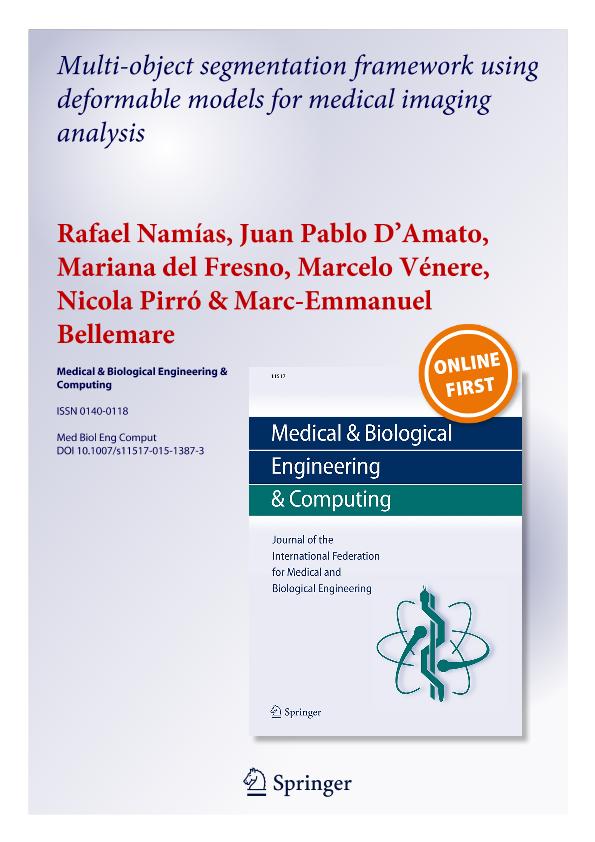Mostrar el registro sencillo del ítem
dc.contributor.author
Namias, Rafael

dc.contributor.author
D'amato, Juan Pablo

dc.contributor.author
del Fresno, Mirta Mariana

dc.contributor.author
Vénere, Marcelo
dc.contributor.author
Pirrone, Nicola

dc.contributor.author
Bellemare, Marc Emmanuel
dc.date.available
2022-12-05T14:44:57Z
dc.date.issued
2015-09
dc.identifier.citation
Namias, Rafael; D'amato, Juan Pablo; del Fresno, Mirta Mariana; Vénere, Marcelo; Pirrone, Nicola; et al.; Multi-object segmentation framework using deformable models for medical imaging analysis; Springer Heidelberg; Medical And Biological Engineering And Computing; 54; 8; 9-2015; 1181-1192
dc.identifier.issn
0140-0118
dc.identifier.uri
http://hdl.handle.net/11336/180170
dc.description.abstract
Segmenting structures of interest in medical images is an important step in different tasks such as visualization, quantitative analysis, simulation, and image-guided surgery, among several other clinical applications. Numerous segmentation methods have been developed in the past three decades for extraction of anatomical or functional structures on medical imaging. Deformable models, which include the active contour models or snakes, are among the most popular methods for image segmentation combining several desirable features such as inherent connectivity and smoothness. Even though different approaches have been proposed and significant work has been dedicated to the improvement of such algorithms, there are still challenging research directions as the simultaneous extraction of multiple objects and the integration of individual techniques. This paper presents a novel open-source framework called deformable model array (DMA) for the segmentation of multiple and complex structures of interest in different imaging modalities. While most active contour algorithms can extract one region at a time, DMA allows integrating several deformable models to deal with multiple segmentation scenarios. Moreover, it is possible to consider any existing explicit deformable model formulation and even to incorporate new active contour methods, allowing to select a suitable combination in different conditions. The framework also introduces a control module that coordinates the cooperative evolution of the snakes and is able to solve interaction issues toward the segmentation goal. Thus, DMA can implement complex object and multi-object segmentations in both 2D and 3D using the contextual information derived from the model interaction. These are important features for several medical image analysis tasks in which different but related objects need to be simultaneously extracted. Experimental results on both computed tomography and magnetic resonance imaging show that the proposed framework has a wide range of applications especially in the presence of adjacent structures of interest or under intra-structure inhomogeneities giving excellent quantitative results.
dc.format
application/pdf
dc.language.iso
eng
dc.publisher
Springer Heidelberg

dc.rights
info:eu-repo/semantics/openAccess
dc.rights.uri
https://creativecommons.org/licenses/by-nc-sa/2.5/ar/
dc.subject
COLLISION CONTROL
dc.subject
COMPLEX SEGMENTATION
dc.subject
DEFORMABLE MODELS
dc.subject
MULTI-OBJECT SEGMENTATION
dc.subject
SEGMENTATION FRAMEWORK
dc.subject.classification
Ciencias de la Información y Bioinformática

dc.subject.classification
Ciencias de la Computación e Información

dc.subject.classification
CIENCIAS NATURALES Y EXACTAS

dc.title
Multi-object segmentation framework using deformable models for medical imaging analysis
dc.type
info:eu-repo/semantics/article
dc.type
info:ar-repo/semantics/artículo
dc.type
info:eu-repo/semantics/publishedVersion
dc.date.updated
2022-12-05T11:02:22Z
dc.journal.volume
54
dc.journal.number
8
dc.journal.pagination
1181-1192
dc.journal.pais
Alemania

dc.description.fil
Fil: Namias, Rafael. Consejo Nacional de Investigaciones Científicas y Técnicas. Centro Científico Tecnológico Conicet - Rosario. Centro Internacional Franco Argentino de Ciencias de la Información y de Sistemas. Universidad Nacional de Rosario. Centro Internacional Franco Argentino de Ciencias de la Información y de Sistemas; Argentina
dc.description.fil
Fil: D'amato, Juan Pablo. Universidad Nacional del Centro de la Provincia de Buenos Aires. Facultad de Ciencias Exactas. Grupo de Plasmas Densos Magnetizados. Provincia de Buenos Aires. Gobernación. Comision de Investigaciones Científicas. Grupo de Plasmas Densos Magnetizados; Argentina
dc.description.fil
Fil: del Fresno, Mirta Mariana. Universidad Nacional del Centro de la Provincia de Buenos Aires. Facultad de Ciencias Exactas. Grupo de Plasmas Densos Magnetizados. Provincia de Buenos Aires. Gobernación. Comision de Investigaciones Científicas. Grupo de Plasmas Densos Magnetizados; Argentina
dc.description.fil
Fil: Vénere, Marcelo. Universidad Nacional del Centro de la Provincia de Buenos Aires. Facultad de Ciencias Exactas. Grupo de Plasmas Densos Magnetizados. Provincia de Buenos Aires. Gobernación. Comision de Investigaciones Científicas. Grupo de Plasmas Densos Magnetizados; Argentina
dc.description.fil
Fil: Pirrone, Nicola. Hopital la Timone; Francia
dc.description.fil
Fil: Bellemare, Marc Emmanuel. Aix-marseille Université; Francia
dc.journal.title
Medical And Biological Engineering And Computing

dc.relation.alternativeid
info:eu-repo/semantics/altIdentifier/url/http://link.springer.com/article/10.1007/s11517-015-1387-3
dc.relation.alternativeid
info:eu-repo/semantics/altIdentifier/doi/http://dx.doi.org/10.1007/s11517-015-1387-3
Archivos asociados
